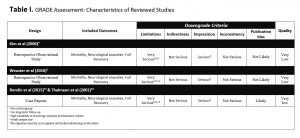Extracorporeal Membrane Oxygenation for Near-Drowning Victims
ABSTRACT
Background: Drowning is the leading cause of death in children worldwide. Likewise, the survival rate of adults found in cardiac arrest by emergency medical personnel after a drowning event is 1.7%. Sequelae attached to near-drowning events are highly varied in type and severity and are often proportional to stretch of anoxia and liquid volume aspirated. Extracorporeal membrane oxygenation is a form of cardiopulmonary bypass allowing heart and/or lung rest post insult by artificially oxygenating, removing CO2 waste, and rewarming blood.
Method: An exhaustive search using MEDLINE-Ovid, Web of Science, and CINAHL was performed using keywords: extracorporeal membrane oxygenation and drowning. These were screened with eligibility criteria. The resulting studies were then appraised and assessed for quality with GRADE. For ethical reasons no prospective, randomized and controlled human studies are available thus all data are derived from retrospective observational studies or individual case reports.
Results: Fifty articles were reviewed for relevance; two retrospective observational studies and two case reports were identified fitting the question under investigation. Due to the nature of the question posed, the quality of the evidence was very low, but one study and both case reports showed a resulting benefit to early intervention with ECMO post near-drowning incident. The second study had the added confounder of each patient suffering moderate too severe hypothermia thus making a conclusion difficult due to relatively high mortality.
Conclusion: Due to the complex nature and high mortality rate of near-drowning victims, ECMO can be used safely and effectively as an adjunct resuscitative strategy for select patients with cardiac and/or pulmonary failure and hypothermia resistant to conventional therapies.
Keywords: Extracorporeal membrane oxygenation, drowning
(Click on image to enlarge.)
REVIEWED STUDIES:
Kim, K. I., Lee, W. Y., Kim, H. S., et al. ( (2014). Extracorporeal membrane oxygenation in near-drowning patients with cardiac or pulmonary failure. Scand J Trauma Resusc Emerg Med, 22, 77.
Weuster, M., Haneya, A., Panholzer, B., et al. (2016). The use of extracorporeal membrane oxygenation systems in severe accidental hypothermia after drowning: A centre experience. ASAIO Journal (American Society for Artificial Internal Organs:1992), 62(2), 157-162.
Romlin, B. S., Winberg, H., Janson, M., et al. (2015). Excellent outcome with extracorporeal membrane oxygenation after accidental profound hypothermia (13.8 degrees C) and drowning. Critical Care Medicine, 43(11), e521-5.
Thalmann, M., Trampitsch, E., Haberfellner, N., et al. (2001). Resuscitaton in near drowning with extracorporeal membrane oxygenation. The Annals of Thoracic Surgery,72(2), 607-60
AUTHOR: Alexander Christy is currently completing his second year in the School of PA Studies at Pacific University, Oregon. He will graduate with an MS degree in August, 2016.


No Comments Yet